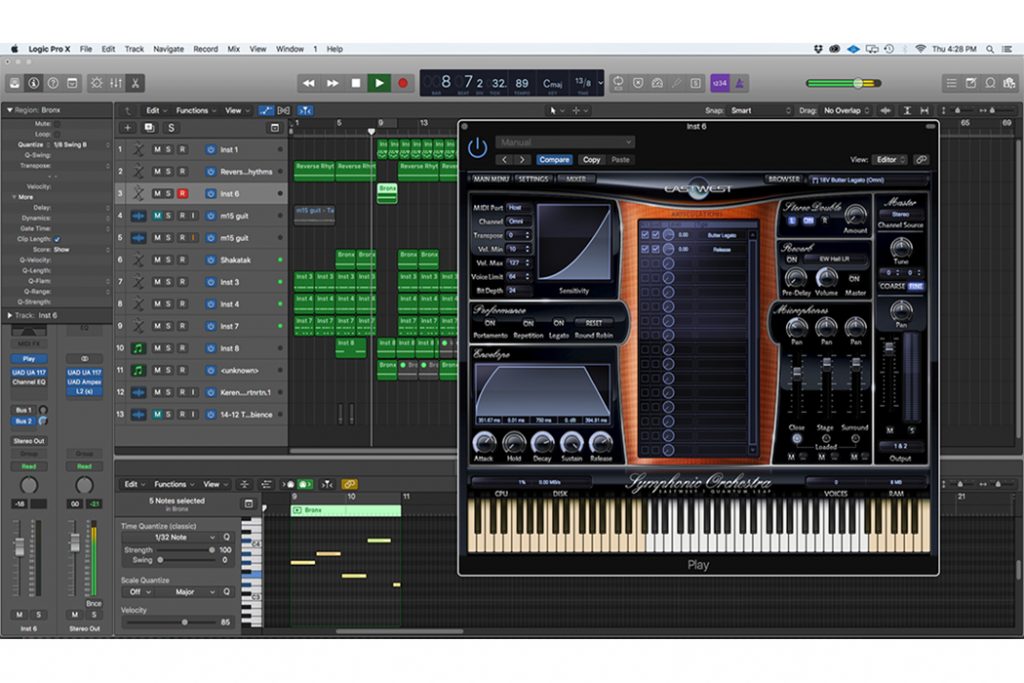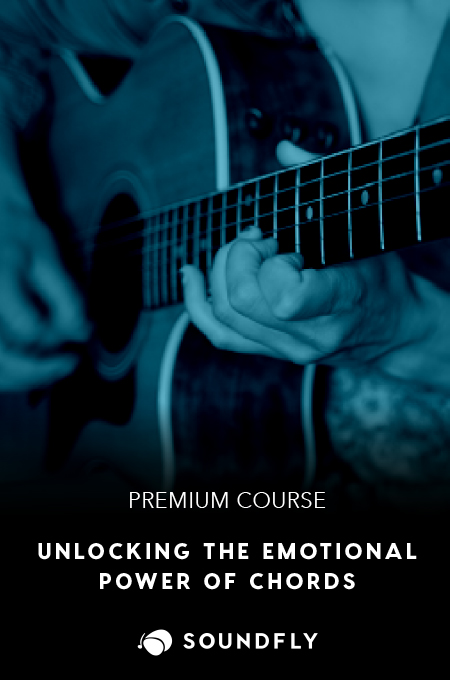As a composer, finding that string library that can do everything you want can often feel like a never-ending quest to find the pot of gold at the end of a rainbow.
New libraries pop up every month or so, all professing to be the best and urging you to press the “buy” button as soon as they’re released. In truth, I don’t think there’s one perfect library. Each one has strengths and weaknesses, and often, a great deal can be achieved by blending several together to create the sound you need.
The appropriate library for you also depends on the type of music you’ll be composing. Some libraries are great for those Zimmer-esque epic tracks and others are better suited for more traditional orchestral pieces. Some libraries are recorded wet — which includes the sound of the room they were recorded in — and some dry with no room ambiance whatsoever. Again, it’s down to personal choice as to which of these you prefer from a workflow and flexibility perspective.
If you’re struggling to get truly expressive performance out of your MIDI strings, whether in Logic or Ableton Live, Soundfly can totally help you out. Check out our brand new free course, Making Realistic MIDI Strings and learn some simple techniques to make your strings sound more human and emotionally effective!
Hollywood Strings Gold/Platinum
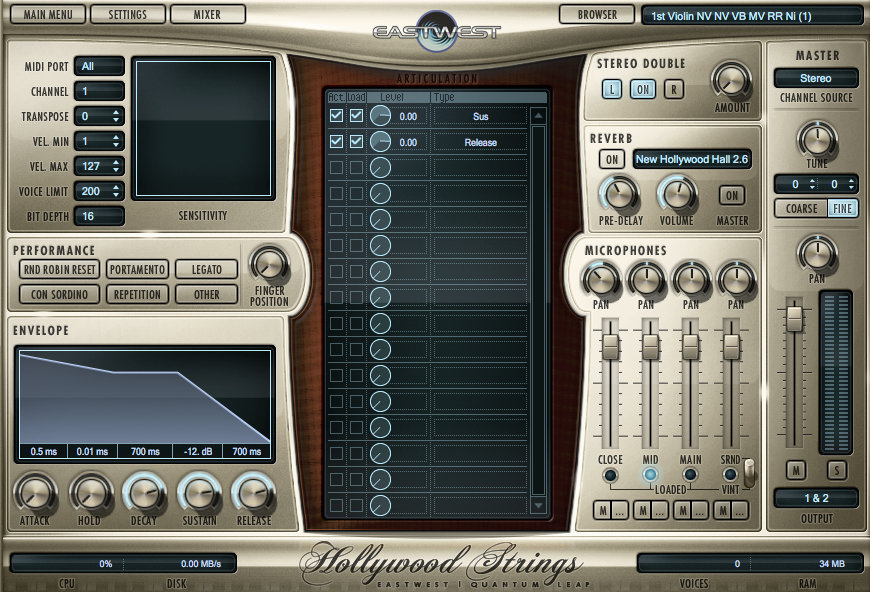
East West Hollywood Strings was created by Hollywood music producers Doug Rogers, Nick Phoenix, Thomas Bergersen, and sound engineer Shawn Murphy.
It certainly lives up to its name with that instantly recognizable “Hollywood” sound. Despite being recorded in a room, I do find it to be relatively dry with only subtle room ambiance when using the main microphones.
It has a bright, lush, present sound, which means it can cut through complex mixes very well. You can enable the built-in reverb and mix it to taste. It has an enormous amount of articulations to play with, currently the largest amount of any library in this list. It does lack FX, though.
It’s more than capable of handling intricate melody pieces as it is barnstorming bombastic tracks. Take a listen to some of the incredible demos on its website to hear what it’s capable of.
Hollywood Strings uses the proprietary EastWest PLAY engine, which has received some criticism over the years. Early versions could be a pain to work with, especially on Mac systems. However, the latest releases appear to have dealt with these issues, and I haven’t experienced any problems recently.
It’s important to take the recommended computer specs on their website seriously. One thing missing from Play is the ability to set up your own key switches, which may be a dealbreaker for some.
The Diamond version comes with additional microphone positions. They sound great, but you do need a very powerful system to run them live. Personally, I have a slave PC which runs Diamond, although my iMac can run Gold quite happily without any complaints.
EastWest has recently launched Composer Cloud, a subscription service allowing you access to the Gold version of all of their libraries. The subscription model isn’t for everyone, but it’s an option, especially for those starting out with reduced funds to purchase libraries outright. Keep in mind, it’s a 12-month contract, and if you don’t continue to subscribe, your libraries will stop working.
Room: EastWest Studios, Hollywood
Microphones: Gold – Mid; Diamond – Close, Mid, Surround
Developer: EastWest
Software: PLAY
Size: 48GB (Gold), 310GB (Diamond)
Pricing: $399.00 (Gold) and $599.00 (Diamond). Subscription service available for Gold.
Download: Yes (Gold only)
Spitfire Chamber Strings
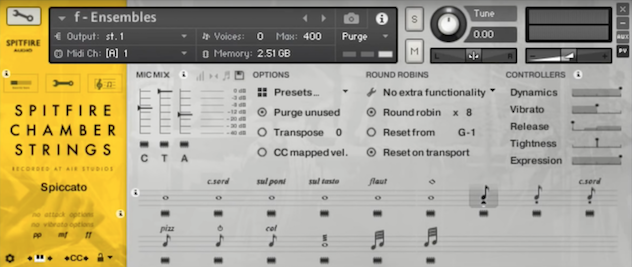
Over the last few of years, Spitfire Audio has taken the orchestral sampling world by storm. The company has a very specific approach when creating their libraries, focusing on using the best players, the best hall, and the best equipment they can to achieve what is a truly stunning sound.
In fact, the hall (Air Lyndhurst Studios in London) is the star of the show. Used by many world-renowned composers to record Hollywood soundtracks, the natural ambiance it lends to the orchestra is both warm and detailed at the same time.
The guys at Spitfire haven’t skimped on anything. Their website describes their recording approach:
Recorded at 96k through vintage valve and ribbon mics to tape through Neve preamps and Prism convertors and presented at 48k, 24-bit in Kontakt format.
The results speak for themselves. Loading any patch and playing a few notes demonstrates an incredibly rich sound; the shorts alone are worth the entry fee. Using the various mic positions and blending them can easily give you the sound you need. The outriggers, in particular, have a sense of space, separation, and width. In fact, I often start with them and then mix in other mics to taste.
Another little gem is the Ostinatum tool, essentially a mini step sequencer that allows you to trigger complex patterns by simply playing a note or a chord. I’ll admit I didn’t use this much at first but have since found it a great tool to play around with different rhythms and use as a “bed” for compositions.
Spitfire has managed to create a relatively simple UI. It’s very easy to switch articulations, change mic positions, and adjust the tightness of the samples. Keyswitches are very easy to set up, and the company has also created the new UACC (Universal Articulation Controller Channel) standard, which uses Midi CC messages instead of note events to change articulations. UACC is still in development, but for those of you using apps like Lemur and ToushOSC, it’s very easy to set up.
Spitfire Chamber Strings is recorded using a smaller string section than the other libraries here, so it lends itself to a more intimate “TV” sound rather than a bombastic Hollywood production. That said, it offers exquisite detail, so it can be layered with other libraries to add presence.
Spitfire has recently changed its approach to releasing libraries. Previously, this library came in several modules in the BML range called Sable. It’s now repackaged so that all articulations are available with the core download, and its expansion pack offers more microphone positions.
The Spitfire range isn’t cheap (you do get what you pay for, though), and price may be a concern if your budget is tight. A word of warning, too — once you’ve bought one of the modules, it can be very difficult not to buy the others!
Room: Air Lyndhurst Studios, London
Microphones: Close, tree, and ambient in the core library; outriggers, close ribbons, and various stereo mixes in the expansion pack
Developer: Spitfire Audio
Software: Kontakt Player and full version
Size: 86.90GB
Pricing: Core – £599 inc. VAT ($773 USD); Expansion – £399.00 inc. VAT ($515 USD)
Download: Yes
+ Soundfly Mainstage: Start your journey arranging music for a string ensemble at last! Join Orchestration for Strings now and get personalized mentor feedback and support in our next Mainstage session starting July 19! Take 15% off with code: MSTAGE17.
Spitfire Symphonic Strings
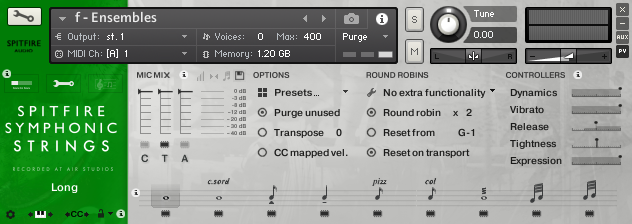
Much of what I’ve said about Spitfire Chamber Strings also applies to Spitfire Symphonic Strings (formerly known as Mural).
The recording process is the same, the hall is the same — the only difference is the size of the string section, which means this library is more suitable for a larger symphonic sound. The core library covers pretty much any articulation you would use in day-to-day work, plus many that you wouldn’t, but nevertheless, it provides a wonderful source of inspiration.
Spitfire Symphonic Strings has a big, open, lush sound. It might not be the library of choice for those of you who need an “in-your-face” sound for hybrid orchestral tracks or trailer music (although with judicious processing, it’s certainly possible). However, if real is what you need, this could be just the thing.
When used in conjunction with other libraries from the Spitfire range, the benefits of the orchestra being recorded in the same space and in the correct positions are notable. Very little mixing is required.
Room: Air Lyndhurst Studios, London
Microphones: Close, tree, ambient in the core library; outriggers, close ribbons, and various stereo mixes in the expansion pack (The expansion pack has yet to be released at time of writing.)
Developer: Spitfire Audio
Software: Kontakt Player and full version
Size: 101GB
Pricing: Core – £699.00 inc. VAT ($902 USD)
Download: Yes
Berlin Strings
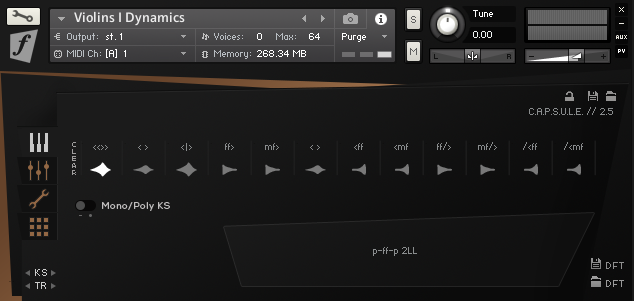
Recorded with a slightly smaller section size than alternative libraries, Berlin Strings aims to capture that large, classical-string sound while keeping playability and detail.
Overall, the company did very well; a wealth of mic positions means it’s very easy to adjust their levels to achieve the sound you need. Be aware that this is a very wet library, with the sound of the Teldex hall baked into the samples. A huge number of articulations are included, probably the most of any library I’ve covered here. I can’t imagine there would be much else a composer would need.
Orchestral Tools has scripted its “Capsule” in Kontakt to handle articulation switching and numerous advanced features, including the ability to apply legato to any long articulation. It’s a very powerful (slightly complex at times) system that can take some time to get used to.
Other innovations include the Runs Builder and Playable Glissandi.
I find the legato patches to be some of the most convincing out there. They’re immediately playable and natural sounding considering the inherent problems associated with recording the samples wet.
Out of all the libraries I’ve reviewed, I find Berlin Strings to sound the most open when all the sections are playing, with each being defined and clearly placed. This makes it very easy to mix with other libraries.
Room: Teldex Scoring Stage, Berlin
Microphones: Close, tree, A/B, and surround
Developer: Orchestral Tools
Software: Kontakt Player and full version
Size: 129GB
Pricing: €840 plus additional taxes ($942 USD)
Download: Yes
+ Read more on Flypaper: “(Artificial) Space is the Place–A Reverb Technology Primer”
Cinematic Strings 2
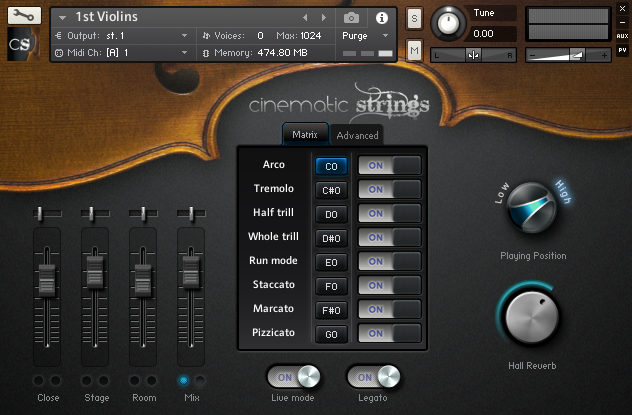
Cinematic Strings 2 is arguably the best string library I’ve used for fast, “quick-and-dirty” music production.
Very popular among media composers on tight deadlines, it ships with just seven instruments: V1, V2, violas, cello, and bass, plus lite and full ensembles. Available articulations are accessible via key switches, and unused articulations can also be unloaded from Kontakt to save on RAM by switching them off.
The sound itself is warm and lush with a convincing vibrato that adds realism to performances. Expression is controlled using the MOD wheel. The legato patches sound fantastic and their transitions smooth, adjusting to the speed at which you play. A staccato overlay is enabled by default, which adds a subtle attack to long articulations; this can also be disabled easily in the UI. The individual staccato and staccatissimo patches are excellent and have the power necessary to knock out those fast, dramatic action cues.
It has a built-in reverb which can easily be turned off if you’d rather have a dryer sound, or you can use your own alternative.
I often use the ensemble patch as a sketch pad to lay down ideas in my DAW quickly to be fine-tuned later.
All in all, Cinematic Strings 2 is a very good library. I have it installed on my laptop hard drive so I can compose on the go without worrying about whether my computer will grind to a halt. I’ve found it layers exceptionally well with LA Scoring Strings, which adds definition, especially on the short notes.
Room: Verbrugghen Hall of the Sydney Conservatorium
Microphones: Close, stage, room, mixed
Developer: Cinematic Strings
Software: Kontakt Player
Size: 38GB
Pricing: $399.00
Download: Yes
+ Read more on Flypaper: “Loud Silence & Quiet Sound–The Illuminating Music of Toru Takemitsu”
LA Scoring Strings

LA Scoring Strings (LASS) is a library that composers appear to either love or hate. It all comes down to the sound — which is completely dry with no room ambiance whatsoever.
Many users point out that it sounds “harsh” and “boxy” to their ears, and while I’d agree this can be the case out of the box, with a little work, it can be a hugely useful tool in your arsenal. The latest version addresses this by adding Stage and Color, which allows you to position instruments, plus add EQ and reverb to taste. It comes with plenty of presets to get you started.
One of the major plus points is the inclusion of divisi patches and incredibly innovative Kontakt scripting called ARC (Audiobro Remote Control). To quote the company’s website:
This is a very powerful tool that allows you to control one, many, or all of LASS’s patches from one place. This saves you time and allows you to experiment with more confidence knowing that you can apply lots of sweeping changes to patches with ease.
It’s well worth watching the videos available on the Audiobro website to give you an idea of what ARC involves and get an idea of its power. Of course, if that all seems far too complicated, all of the patches can be loaded separately.
The legato patches are incredibly playable; velocity sensitivity switches playing styles between portamento, glissando, and legato.
The library has a remarkably small footprint, making it perfect for installing on your laptop for when your muse strikes while you’re on the go.
Ironically, the very reason some find the sound “harsh” makes it a great choice to layer with wetter libraries to add definition or some presence to quick, legato passages. It mixes particularly well with Spitfire Symphonic Strings and Cinematic Strings 2.
So, in summary, LASS can be something of a beast to tame — there’s certainly a learning curve when it comes to using the ARC and getting the sound you want — but with a little work, it can yield fantastic results.
Room: N/A
Microphones: N/A
Developer: Audio Bro
Software: Kontakt Player
Size: 16.4GB
Pricing: $799.00
Download: Yes
Other Contenders
There are several other popular string libraries available on the market, such as the various 8Dio Strings, VSL, Cinestrings, and Cinematic Studio Strings. At this point, I don’t have any experience with them, but will add them to this list should I use them in the future.
Once again, if you’re serious about using MIDI string libraries in your music, whether for a film score or an epic rock ballad, maximize the emotional pull and expressiveness of the performance with Making Realistic MIDI Strings.
—
 Jonathan Wright is a soundtrack and video game music composer based in London and Cambridge, UK. His music has been used in trailers, video games, and on TV, including shows on NBC, CBS, Discovery, History, EuroSport, the BBC, Channel Four and Channel Five.
Jonathan Wright is a soundtrack and video game music composer based in London and Cambridge, UK. His music has been used in trailers, video games, and on TV, including shows on NBC, CBS, Discovery, History, EuroSport, the BBC, Channel Four and Channel Five.
